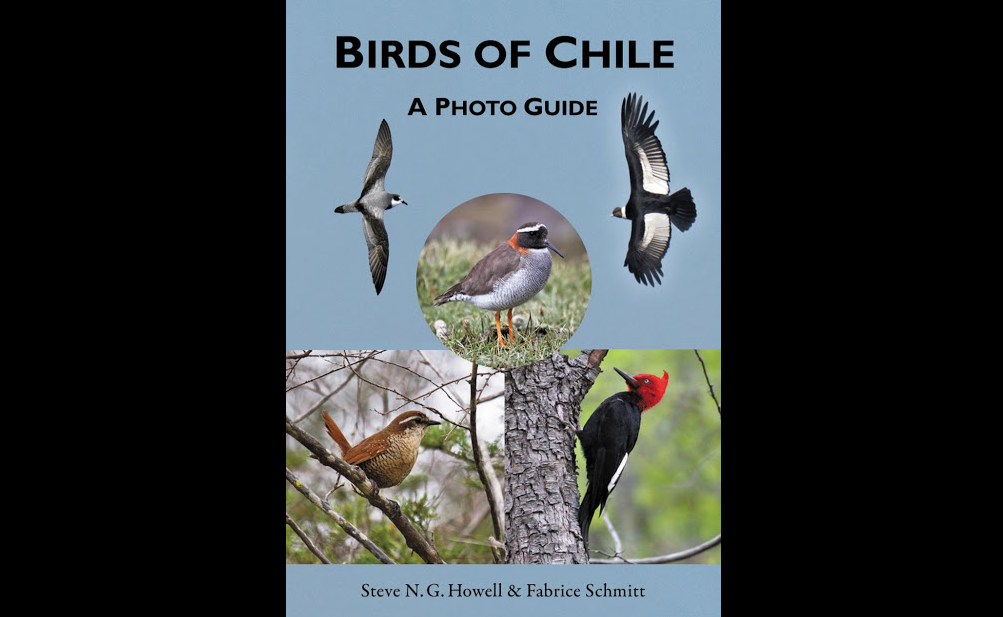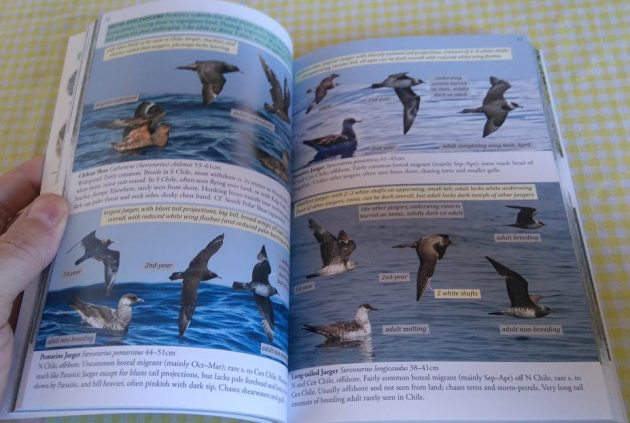
If you want to write a bird guide, you should have guided people yourself. Being a professional ornithologist and knowing your field well is great, but only after you try to pass your expertise to others in the field you do realise how insufficient some descriptions may be and what type of info visiting birders are looking for in a new country.
And that is what recommends Steve N. G. Howell and Fabrice Schmitt: both of them are international bird tour leaders with WINGS. Guiding aside, Howell is a research associate at the California Academy of Sciences and the author of many books, including Petrels, Albatrosses, and Storm-Petrels of North America (Princeton). Schmitt is a lecturer on Ponant Antarctic cruises who lived in Chile from 2005 to 2015, and helped develop the eBird online birding tool for Chile and the rest of South America.
Birds of Chile – A Photo Guide has 240 pages and more than 1,000 photos accompanied by a brief text to make bird ID easy. The authors wrote: [Species] “are the currency of field guides and of birding, but deciding what to treat as ‘species’ is inevitably a subjective endeavour. … We have tended to a liberal (= realistic) direction when recognising species.” Well, this is one interesting claim.
There are about 440 to 540 bird species recorded in Chile (depending on your source), but I was unable to find the data on how many species are dealt with in this photo guide. There are 191 pages of the bird guide proper, dealing with (mostly) two species per page, so there could be about 382 species covered, plus 60 vagrants in the appendix, and if my maths is correct, about 450 species are described.
The authors continue: “Although an appreciation of taxonomic relationships may be intellectually stimulating, arranging bird families according to taxonomic sequence is not necessarily helpful for field identification. … Rather than attempt to keep up with a seemingly ever-changing landscape of higher-level taxonomy, we have arranged birds in field-friendly groupings … whereby birds that appear similar are placed near each other…”
If you asked me ten years ago, I would strongly stand against such grouping, but after seeing too many changes in bird systematics I feel it’s time to drop the taxonomic order from field guides (yes!) and I am glad to see this bold move in this book. So, the birds are grouped under:
Swimming waterbirds
Flying waterbirds
Walking waterbirds
Gamebirds and allies
Raptors and owls
Larger landbirds
Aerial landbirds
Songbirds
Birds of Chile – A Photo Guide starts with a rather detailed intro on regions and habitats. Textual descriptions of species are quite concise, focusing on regions where the bird is to be found, its habitats, behaviour and calls/songs, all the while leaving the bird description – the most important field marks only – to the very short text in yellow boxes within the photos. The photos include both close-ups and birds-in-habitat images to further aid identification. There are no species distribution maps, only textual descriptions.

And now – the photos. Most photos are good to reasonably good documentary shots. Waterbirds and raptors in flight, against the contrasting sea or sky, work especially well. Landbirds and songbirds do not work so well: some photos are dark (shot on a cloudy day), few are on the edge of being blurred, in some cases the bird is partially obscured by vegetation and in many cases it doesn’t stand out, but blends into the background (possibly my biggest complaint when it comes to photos).
The conclusion is, Birds of Chile – A Photo Guide is a recommended piece of work. The text is well written by authors who know and understand their readers, it is easy to follow in the field and the main field marks are highlighted. Regarding the photos, as a rule of a thumb non-passerines and larger birds in general are shown well, although the quality of photos of smaller landbirds and songbirds for this particular identification purpose varies. Also, the book is really compact (5 3/4″ x 8 1/4″, 500 grams) and easy to pack and carry.
Finally, many beginners tend to find traditional bird paintings intimidating, preferring what they see as more user-friendly – photos, instead. In addition, this guide makes for a good photographic backup source to more experienced birders.
Birds of Chile – A Photo Guide
by Steve N. G. Howell and Fabrice Schmitt
Weight: 1.06 pounds
Paperback: 240 pages
Dimensions: 5.75 x 0.75 x 8.25 inches
ISBN: 9780691167398
Publisher : Princeton University Press (05/01/2018)











Leave a Comment